Trial Installation
Due to improvements and updates in the Leapwork Automation Platform, two installation and activation configurations have been developed.
The first configuration applies to installations from version 2024.2.32 onwards, while the second one is applicable for before version 2024.2.32 installations. Below are the detailed steps for both configurations.
To get an overview of the components of the Leapwork Automation Platform, see Architecture Overview.
From version 2024.2.32 onwards
To get an overview of the components of the Leapwork Automation Platform, see Architecture Overview.
This guide aims to walk you through the installation and activation of the Leapwork trial version, ensuring you can efficiently set up and use its components from the very first step.
Installation Guide
To start the installation, follow the steps below:
- Download the latest release from the Customer Portal.
- Save and transfer the file to the local system.
- Navigate to the location of the MSI file and double-click the .msi file to start the installation.
- Click the Next button to begin the installation.
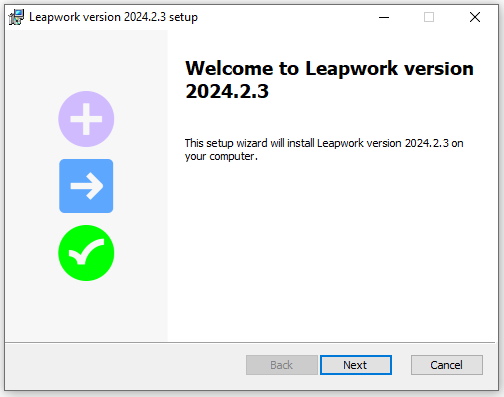
- Read the end user agreement, select the I accept the terms in the license agreement checkbox, and click the Next button.
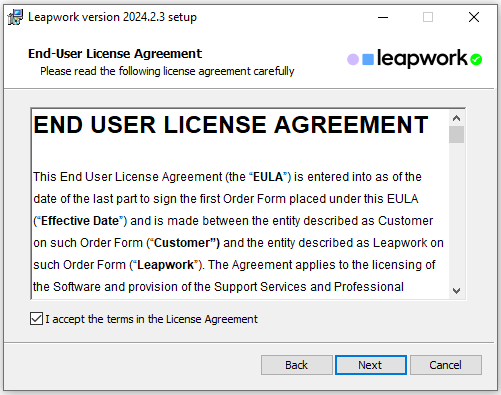
- Click the dropdown menu to select the components you want to install and click the Next button. Refer to Working with Leapwork for more information.
Note: For trial purposes, keep the default selection (all three components). The Configuration screen includes settings for multiple components. Settings can later be modified in the configuration files for each component: studio\studio.config, controller\controller.config, and agent\agent.config. The installation directory: C:\program files\LEAPWORK contains these files.
The Configuration screen includes settings for multiple components. Settings can later be modified in the configuration files for each component: studio\studio.config, controller\controller.config, and agent\agent.config. The installation directory: C:\program files\LEAPWORK contains these files.
Note: For a version upgrade, select Use Configuration, then click the Next button and move to step 10 of this guide.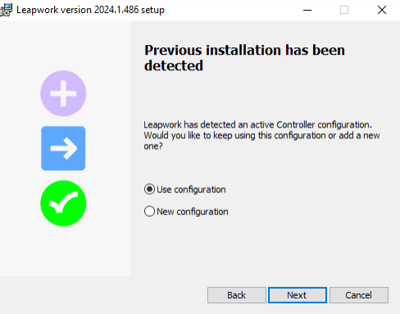
- Enter the License Key and click the Next button.
Note: You can obtaiin the license key from the Customer Portal.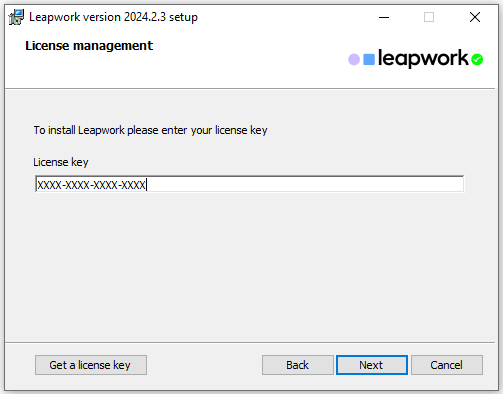
- Enter the port codes for the automation controller and the automation controller API.
Controller Port: Studio and the Controller make API calls using a TCP port. The default is port 9000, you can change to any other port number that is not in use by other software on your computer.
Controller API Port: For integration, access Leapwork's open REST API using the port number set here. The default port is 9001. You can change to any other port number that is not in use by other software on your computer.
Note: We do not recommend changing the Controller, Controller API, or Agent port numbers.
Add Exceptions for the Controller in Windows Firewall: Select this option to add a rule to the Windows Firewall to permit all incoming connections to the Controller.
Note: The password is optional. The Leapwork Automation Platform is used in corporate and secured test networks.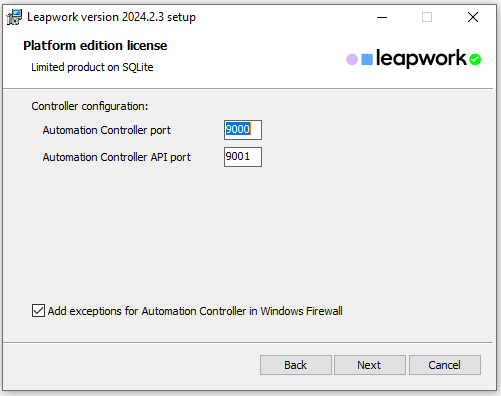
- Specify the paths for both assets and video.
Path to Assets: This is the path to the file system folder which contains the encrypted SQLite database files holding all Leapwork assets, automation flows, schedules, and run results. WARNING: SAVE THE DATABASE ENCRYPTION KEY. It protects the database files created during the upgrade and enables the Controller to access them. The key is necessary if the Controller needs to be moved to a new machine or to restore the Leapwork system. Store the key in a secure and safe place.
WARNING: SAVE THE DATABASE ENCRYPTION KEY. It protects the database files created during the upgrade and enables the Controller to access them. The key is necessary if the Controller needs to be moved to a new machine or to restore the Leapwork system. Store the key in a secure and safe place. - Specify a password for the default user (Admin) and click the Next button. Use the admin user in Studio after the installation.
Note: The admin password is securely located in your local installation. In case you forget it, Leapwork cannot assist in retrieving the password. Adjust the settings on the configuration screen before completing the installation. Leapwork Agents can log into Windows automatically, removing the need for the user to be logged in to run a flow. It also supports testing Single Sign-on between Windows and other applications.
Adjust the settings on the configuration screen before completing the installation. Leapwork Agents can log into Windows automatically, removing the need for the user to be logged in to run a flow. It also supports testing Single Sign-on between Windows and other applications. - Select either Windows login or set a password, which is blank by default, and click the Next button.
Agent Port: Automation flows operate within the Agent, which communicates with Studio and the Controller via a closed remote-control protocol on a designated TCP port. The default port is 6777, but this can be changed to any other unused port. WARNING: IT IS ADVISED NOT TO CHANGE THE CONTROLLER, CONTROLLER API, OR AGENT PORT NUMBERS UNLESS ABSOLUTELY NECESSARY.
WARNING: IT IS ADVISED NOT TO CHANGE THE CONTROLLER, CONTROLLER API, OR AGENT PORT NUMBERS UNLESS ABSOLUTELY NECESSARY.
Agent Password: Because the Agent uses a remote-control protocol, it is advised to set a password to prevent unauthorized access.
Note: Leapwork Agent passwords will begin deprecation and are expected to be removed from the product before the end of the year.
Add Exceptions for the Agent in Windows Firewall: A check in this box will direct the installation process to add a rule to the Windows Firewall to permit all incoming connections to the Agent.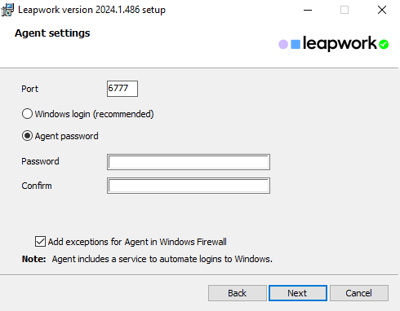
- Click the Install button.
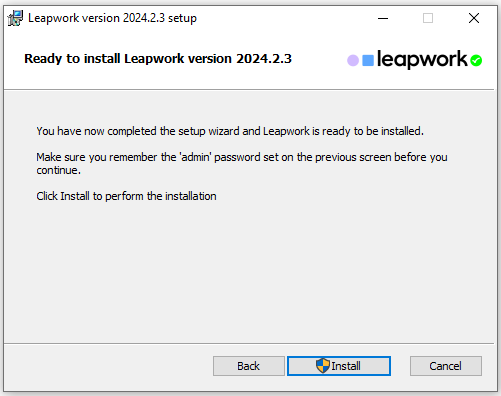
- Click the Finish button to exit the installer.
 Note: If there is an existing distributed setup of Leapwork, repeat the installation guide for each Leapwork component and machine in the environment.
Note: If there is an existing distributed setup of Leapwork, repeat the installation guide for each Leapwork component and machine in the environment.
Activation Guide
If you already have the software installed but need to perform activation, follow these steps:
- After installing all Leapwork components, start Leapwork Studio. The Controller will broadcast its IP address, so Studio usually knows its location on the first start.
- Log in as admin, Studio will prompt you to enter the license key.
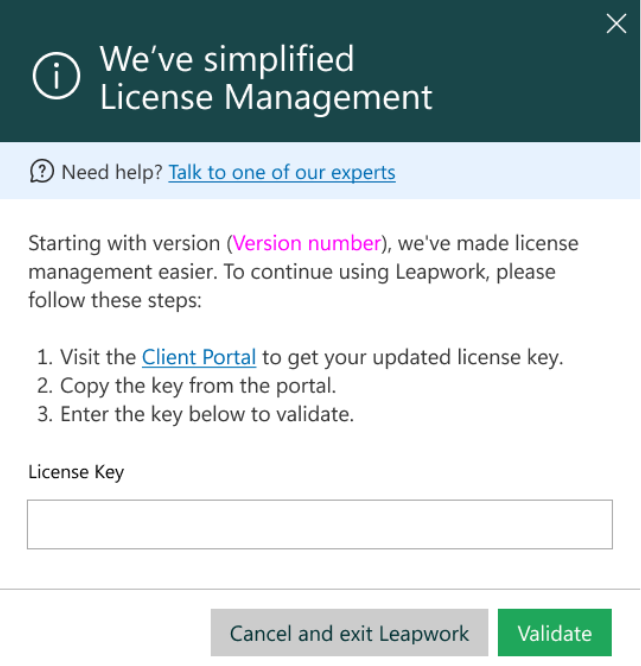
- Click the Customer Portal link.
- Copy the License Key.

- Paste the License Key in the provided field.
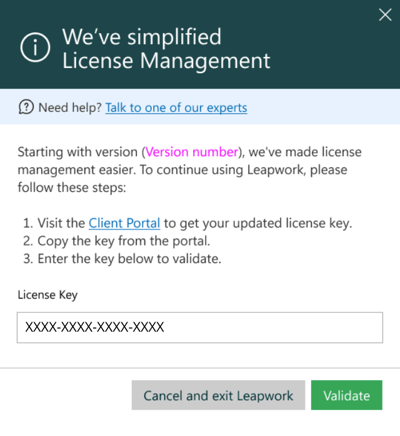
- Click the Validate button.
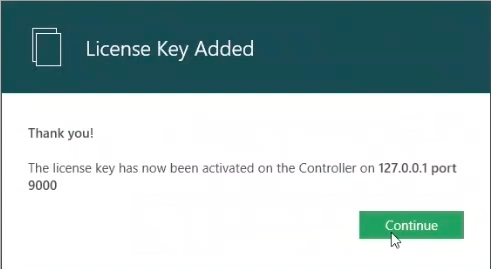
- After a successful activation, click the Continue button.
Note: If you encounter any problems with the login, please contact Leapwork Customer Support.
Before version 2024.2.32
This guide aims to walk you through the installation and activation of the Leapwork trial version, ensuring you can efficiently set up and use its components from the very first step.
Installation Guide
To start the offline installation, follow the steps below:
- Download the latest release from the Releases page.
- Save and transfer the file to the local system.
- Navigate to the location of the MSI file and double-click the .msi file to start the installation.
- Click the Next button to begin the installation
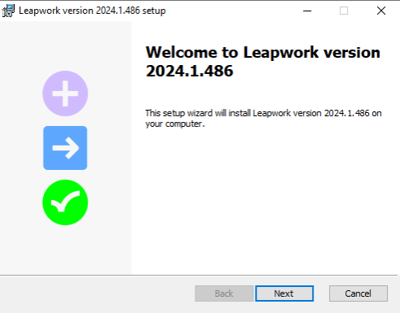
- Read the end user agreement, select the I accept the terms in the license agreement checkbox, and click the Next button.
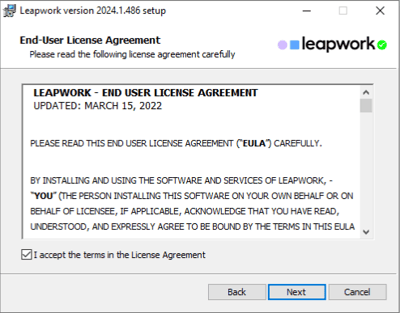
- Click the dropdown menu to select the components you want to install and click the Next button. Refer to Working with Leapwork for more information.
Note: For trial purposes, keep the default selection (all three components).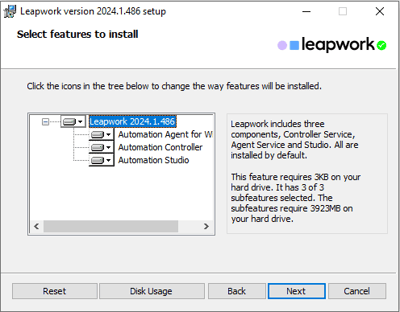
The Configuration screen includes settings for multiple components. Settings can later be modified in the configuration files for each component: studio\studio.config, controller\controller.config, and agent\agent.config. The installation directory: C:\program files\LEAPWORK contains these files. - If you are installing the software for the first time, select New Configuration and click the Next button.
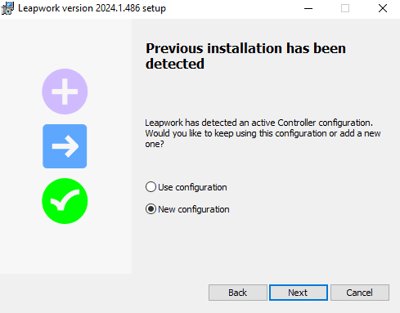
- If you have a previous version installed, click Use Configuration, then click the Next button and move to step 11 of this guide.

- Choose one of the following options:
- I don’t have a license: Proceed with the installation. You will need to activate the product later.
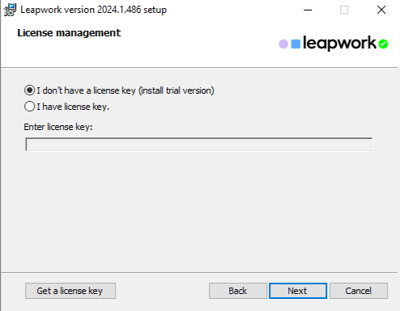
- I have a license: Enter the license key in the provided field.
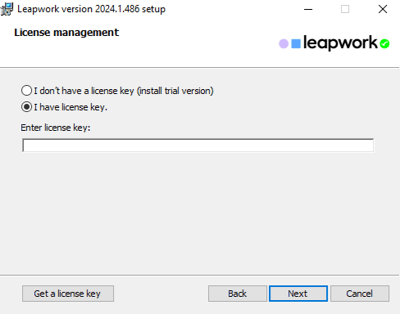
- I don’t have a license: Proceed with the installation. You will need to activate the product later.
- Click the Next button.
- Enter the port codes for the automation controller and the automation controller API.
Controller Port: Studio and the Controller make API calls using a TCP port. The default is port 9000, you can change to any other port number that is not in use by other software on your computer.
Controller API Port: For integration, access Leapwork's open REST API using the port number set here. The default port is 9001. You can change to any other port number that is not in use by other software on your computer.
Note: We do not recommend changing the Controller, Controller API, or Agent port numbers.
Add Exceptions for the Controller in Windows Firewall: Select this option to add a rule to the Windows Firewall to permit all incoming connections to the Controller.
Note: The password is optional. The Leapwork Automation Platform is used in corporate and secured test networks.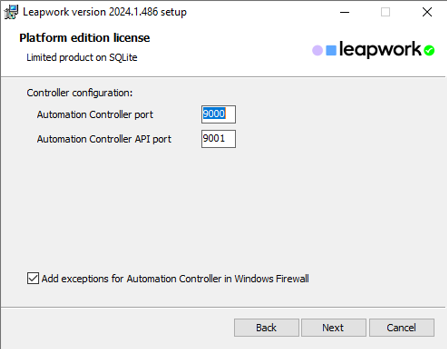
- Specify the paths for both assets and video.
Path to Assets: This is the path to the file system folder which contains the encrypted SQLite database files holding all Leapwork assets, automation flows, schedules, and run results. WARNING: SAVE THE DATABASE ENCRYPTION KEY. It protects the database files created during the upgrade and enables the Controller to access them. The key is necessary if the Controller needs to be moved to a new machine or to restore the Leapwork system. Store the key in a secure and safe place.
WARNING: SAVE THE DATABASE ENCRYPTION KEY. It protects the database files created during the upgrade and enables the Controller to access them. The key is necessary if the Controller needs to be moved to a new machine or to restore the Leapwork system. Store the key in a secure and safe place. - Specify a password for the default user (Admin) and click the Next button. Use the admin user in Studio after the installation.
Note: The admin password is securely located in your local installation. In case you forget it, Leapwork cannot assist in retrieving the password. Adjust the settings on the configuration screen before completing the installation. Leapwork Agents can log into Windows automatically, removing the need for the user to be logged in to run a flow. It also supports testing Single Sign-on between Windows and other applications.
Adjust the settings on the configuration screen before completing the installation. Leapwork Agents can log into Windows automatically, removing the need for the user to be logged in to run a flow. It also supports testing Single Sign-on between Windows and other applications. - Select either Windows login or set a password, which is blank by default, and click the Next button.
Agent Port: Automation flows operate within the Agent, which communicates with Studio and the Controller via a closed remote-control protocol on a designated TCP port. The default port is 6777, but this can be changed to any other unused port. WARNING: IT IS ADVISED NOT TO CHANGE THE CONTROLLER, CONTROLLER API, OR AGENT PORT NUMBERS UNLESS ABSOLUTELY NECESSARY.
WARNING: IT IS ADVISED NOT TO CHANGE THE CONTROLLER, CONTROLLER API, OR AGENT PORT NUMBERS UNLESS ABSOLUTELY NECESSARY.
Agent Password: Because the Agent uses a remote-control protocol, it is advised to set a password to prevent unauthorized access.
Note: Leapwork Agent passwords will begin deprecation and are expected to be removed from the product before the end of the year.
Add Exceptions for the Agent in Windows Firewall: A check in this box will direct the installation process to add a rule to the Windows Firewall to permit all incoming connections to the Agent.
- Click the Install button.
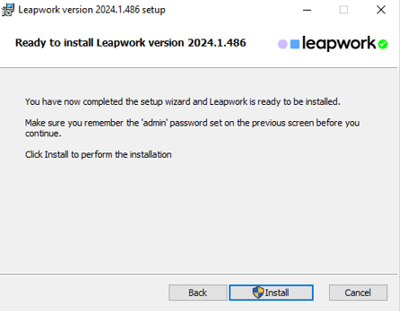
- After the installation is complete, click the Skip button.
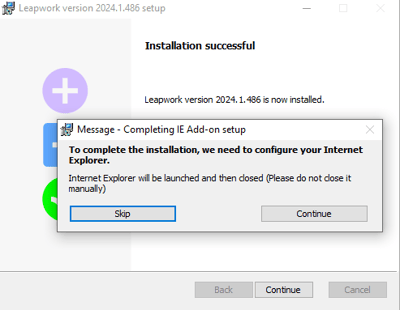
- Click the Finish button to exit the installer.
 Note: If there is an existing distributed setup of Leapwork, repeat the installation guide for each Leapwork component and machine in the environment.
Note: If there is an existing distributed setup of Leapwork, repeat the installation guide for each Leapwork component and machine in the environment.
Activation Guide
If you already have the software installed but need to perform activation, follow these steps:
- After installing all Leapwork components, start Leapwork Studio. The Controller will broadcast its IP address, so Studio usually knows its location on the first start. Log in as admin, Studio will prompt you to enter the license key.
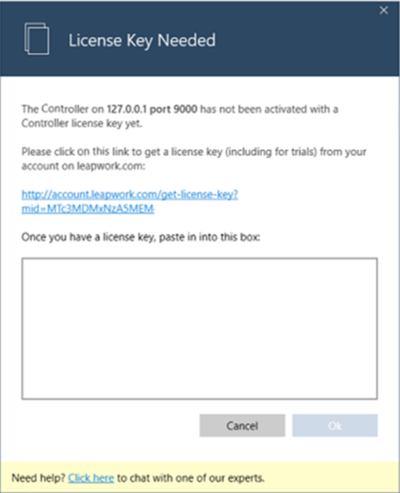
- Click the link in the dialogue to obtain the license key. This action will open a browser.
- Log in using your e-mail and the password provided when signing up on Leapwork.
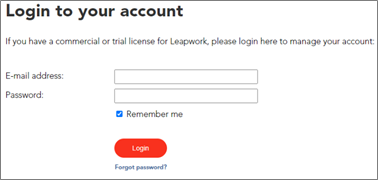
- Click Copy license key to copy the license key.
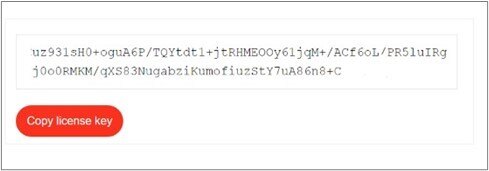
- Return to Studio.
- Paste the copied license key into the provided field.
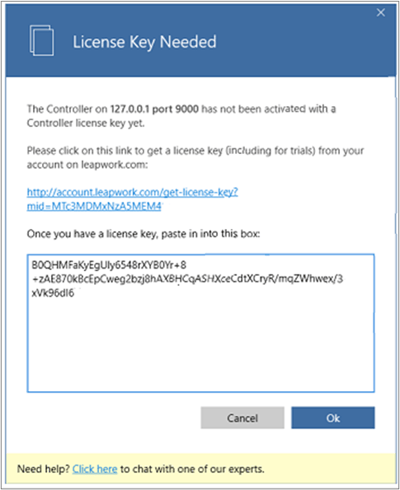
- Click OK.
- After a successful login on leapwork.com, the license management page opens.
Note: If you encounter any problems with the login, please contact Leapwork Customer Support.